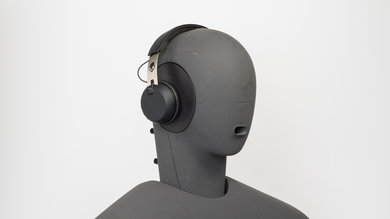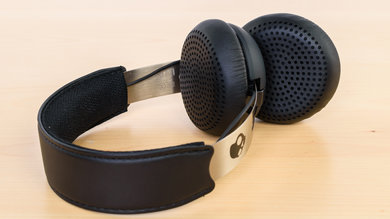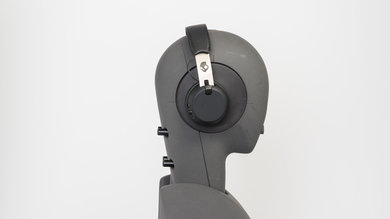The Skullcandy Grind are versatile and comfortable on-ear headphones. They have an above-average sound, they're lightweight and surprisingly comfortable for an on-ear model. However, they're not as portable as some of the other on-ears we've tested, and they do not block a lot of noise so they won't be the ideal headphones for loud environments.
Our Verdict
The Grind are decent mixed usage headphones. They're quite comfortable for an on-ear design, they have an efficient and easy-to-use control scheme and a sturdy build quality. Unfortunately, they do not block enough noise for commuting, and they're slightly too unstable for sports. On the upside, they deliver an above-average audio reproduction which should be good enough for most listeners.
-
Above-average sound quality.
-
Sturdy and comfortable design.
-
Poor noise isolation.
-
Less portable than most on-ears.
Above-average for neutral listening. They have a decently balanced audio reproduction that caters well to instruments and vocals. Their bass is not too overwhelming but the Treble range can sometimes be a bit too sharp on some tracks. Unfortunately, they don't have the best Soundstage due to their small and closed-back ear cups but they should sound good enough for most listeners.
Mediocre for commuting. They a lot of noise seep into your audio which is not suitable for the loud environments involved in commuting.
Average for sports. They're wireless with an easy to use control scheme and they do not get too hot when exercising. However, they are not the most stable and ear cups sway a lot while running which is not ideal for sports.
Average for office-use. They have an efficient and easy to use control scheme, but they're a bit leaky at high volumes and they won't block the noise of a particularly lively office.
- 6.6 Mixed Usage
- 7.3 Neutral Sound
- 6.3 Commute/Travel
- 7.1 Sports/Fitness
- 6.4 Office
- 5.4 Wireless Gaming
- 7.1 Wired Gaming
- 6.0 Phone Call
Changelog
- Updated Nov 21, 2019: Converted to Test Bench 1.3.1.
- Updated Nov 21, 2019: Converted to Test Bench 1.3.
- Updated Feb 16, 2018: Converted to Test Bench 1.2.
- Updated Sep 28, 2017: The microphone has been tested with our new methodology, as explained here
- Updated Aug 15, 2017: Review published.
Check Price
Compared To Other Headphones
The Skullcandy Grind are one of the best closed-back headphones we've tested in this price range. See our recommendations for the best headphones under $50 and the best wireless headphones under $100.
The Skullcandy Grind Wireless are much better on-ear headphones than the JBL T450BT Wireless. The Grind have a great build quality for their price; they're also a lot more comfortable than the T450BT. The Grind also have longer battery life, a slightly better-balanced sound quality, and a headphone jack so you can use them wired with most devices, unlike the JBLs. On the other hand, the JBLs have a more compact and portable design that folds and can even fit into some larger jacket pockets. They're also lighter and leak a little less at high volumes.
Overall, the Skullcandy Grind Wireless are better headphones than the Sony WH-CH500 Wireless. The Skullcandy have a more accurate bass response, which some may prefer, and their on-ear design is more comfortable. You can also use them wired, even if the battery is dead, and they don’t feel as cheap as the Sony. On the other hand, the Sony have a slightly better battery life with power-saving features, which the Skullcandy lack, and have a better wireless range.
The Skullcandy Grind Wireless are more comfortable on-ear headphones, and you can use them wired. They’ll be more versatile than the Sony WH-CH400 Wireless, and they're noticeably more durable. These headphones will sound fairly similar, but the Skullcandy will have a more accurate bass for most, with a slightly V-shaped sound profile. They also take about half the time to charge, which is nice. However, the Skullcandy don’t support NFC like the Sony, but you can use them wired and get an in-line microphone, which the Sony are lacking.
Test Results
The Skullcandy Grind have a straightforward on-ear design that will work for some. They have thin but large metal frame and small circular ear cups. They don't have any folding hinges, so they have a very minimalistic look with few moving parts. They also come in a couple of color schemes that will stand out a bit more than the black color variant we've reviewed.
The Skullcandy Grind are surprisingly comfortable on-ear headphones. They're lightweight, and the padding on the ear cups is soft. They're comfortable to wear for hours, unlike most similarly designed headphones which put quite a bit of pressure on your ears. However, the headband is not as decently padded as the ear cups. If you're looking for a pair of wireless on-ear headphones that have a fit better-suited for your kids, check out the JBL JR300BT Wireless.
The Skullcandy Grind have an efficient and easy-to-use control scheme. The button layout is good, and the buttons are responsive providing track-skipping, call/music, and volumes controls. The buttons may be a bit difficult to distinguish by touch a lone at first, but they don't take too long to get familiar with.
The Skullcandy are relatively small on-ear headphones that unfortunately do not fold into a more compact format. This makes them less portable than other on-ears we've reviewed and a bit more of a hassle to carry around on your person if you don't have a bag.
The Grind have an above-average build quality. The headband is a thin but has wide metal frame that feels durable and sturdy enough for most use cases. The ear cups are not especially dense but can easily withstand a shoulder height drop unscathed. However, the audio cable from the headband to the ear cups are exposed and could get damaged from regular wear and tear and head band although sturdy does not feel very flexible and could get bent out of shape with enough force.
These headphones are quite stable. They're able to maintain their position and fit during casual listening sessions. Their wireless design also prevents them from being yanked off your head because the audio cable got hooked by the something. However, they are not designed for sports and will start to slip off your ears during high-intensity activities like running or working out.
Average consistency. The Bass Range of the Grind is susceptible to inconsistencies depending on the positioning preference and head shape of the user. The maximum deviation we measured was -3dB at 300Hz which is quite significant. The consistency in the Treble Range, however, is very good.
Excellent Bass Range performance. Low-frequency extension is at 14Hz which is great. The overall response is virtually flat and only slightly over our target. This will give more emphasis to Bass Range of these headphones.
Very good Mid Range performance. Low-mid is only slightly over our target, and it is the continuation of the high-bass overemphasis. The dip surrounding 700Hz pushes vocals/leads to the back of the mix, but at -4dB the effect will be subtle. High-mid is well-balanced but shows a tilt favoring the Treble frequencies.
Mediocre Treble Range performance. Low-treble is over our target by about 2dB, giving a bit of excess presence to the sound. Treble has a 5dB bump between 5KHz and 10KHz, making these headphones sibilant and piercing to those with sensitive ears.
Poor Isolation. These on-ear headphones do not isolate at all in the Bass Range, and only 1.5dB in the Mid Range. In the Treble Range, they achieve about 29dB of isolation, which is decent.
Average Leakage. The significant portion of the Leakage is spread between 500Hz and 6KHz which is a relatively broad range. However, the overall level of Leakage is not too loud.
The Grind delivers up to 15 hours of continuous playback at average volumes. They also don't take too long to fully charge at 1.5 hours. Unfortunately, they do not have an auto-off timer to help prolong their battery life, and you can't use them while they are charging. On the upside, they can be used completely passively even when the batteries are dead.
No compatible app.
These headphones are Bluetooth compatible but don't support NFC. If NFC is a must-have for you, take a look at the Sony WH-CH400.
These headphones do not support any additional codecs. This means their base SBC latency is about 165ms which is fine for streaming music but maybe become an issue when watching videos or gaming. The slight sync issues are even more prominent on high frame rate content.
Comments
Skullcandy Grind Wireless: Main Discussion
Let us know why you want us to review the product here, or encourage others to vote for this product.



























































































